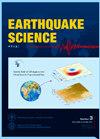A correlation study of selected geomagnetic events recorded by the Egyptian observatories and INTERMAGNET stations
IF 4.1
4区 地球科学
Q3 Earth and Planetary Sciences
引用次数: 0
Abstract
Geomagnetic observatory data are crucial for all branches of geophysics because they can contribute to earthquake research by detecting anomalies in the Earth’s magnetic field. Recently, data records from the Misallat (MLT) and Abu Simbel (ABS) Egyptian geomagnetic observatories were processed and found to be of good quality. In this study, Egyptian observatory data were tested during both quiet and disturbed events and compared with data from INTERMAGNET observatories worldwide at different latitudes and within a narrow range of longitudes in both hemispheres. This study investigated the relationships between magnetic field components from Egyptian observatories and those from INTERMAGNET observatories using graphical representations of the X components; Pearson’s correlation for the X, Y, Z, and F components; cross-correlation for the X component; and wavelet coherence for the F component. The results of this study showed a high correlation between Egyptian observatories and all utilized INTERMAGNET stations, except those located at high latitudes, during both quiet and disturbed events. Additionally, the study confirmed the observed consistency between Egyptian observatories and selected INTERMAGNET stations. Therefore, Egyptian observatories can feasibly fill the gap in the Middle East and North Africa.
埃及天文台和INTERMAGNET台站记录的选定地磁事件的相关性研究
地磁观测数据对地球物理学的所有分支都是至关重要的,因为它们可以通过探测地球磁场的异常情况来促进地震研究。最近,对埃及Misallat (MLT)和Abu Simbel (ABS)地磁观测站的数据记录进行了处理,发现质量很好。在这项研究中,埃及天文台的数据在平静和扰动事件期间进行了测试,并与INTERMAGNET在两个半球不同纬度和狭窄经度范围内的全球天文台的数据进行了比较。本研究利用X分量的图形表示研究了埃及天文台和INTERMAGNET天文台磁场分量之间的关系;X、Y、Z和F分量的Pearson相关性;X分量的相互关系;F分量的小波相干性。这项研究的结果表明,在平静和扰动事件期间,埃及天文台与所有利用的INTERMAGNET台站之间存在高度相关性,位于高纬度地区的台站除外。此外,该研究证实了埃及观测站与选定的INTERMAGNET观测站之间观测到的一致性。因此,埃及的天文台可以填补中东和北非的空白。
本文章由计算机程序翻译,如有差异,请以英文原文为准。
求助全文
约1分钟内获得全文
求助全文
来源期刊

Earthquake Science
GEOCHEMISTRY & GEOPHYSICS-
CiteScore
1.10
自引率
8.30%
发文量
42
审稿时长
3 months
期刊介绍:
Earthquake Science (EQS) aims to publish high-quality, original, peer-reviewed articles on earthquake-related research subjects. It is an English international journal sponsored by the Seismological Society of China and the Institute of Geophysics, China Earthquake Administration.
The topics include, but not limited to, the following
● Seismic sources of all kinds.
● Earth structure at all scales.
● Seismotectonics.
● New methods and theoretical seismology.
● Strong ground motion.
● Seismic phenomena of all kinds.
● Seismic hazards, earthquake forecasting and prediction.
● Seismic instrumentation.
● Significant recent or past seismic events.
● Documentation of recent seismic events or important observations.
● Descriptions of field deployments, new methods, and available software tools.
The types of manuscripts include the following. There is no length requirement, except for the Short Notes.
【Articles】 Original contributions that have not been published elsewhere.
【Short Notes】 Short papers of recent events or topics that warrant rapid peer reviews and publications. Limited to 4 publication pages.
【Rapid Communications】 Significant contributions that warrant rapid peer reviews and publications.
【Review Articles】Review articles are by invitation only. Please contact the editorial office and editors for possible proposals.
【Toolboxes】 Descriptions of novel numerical methods and associated computer codes.
【Data Products】 Documentation of datasets of various kinds that are interested to the community and available for open access (field data, processed data, synthetic data, or models).
【Opinions】Views on important topics and future directions in earthquake science.
【Comments and Replies】Commentaries on a recently published EQS paper is welcome. The authors of the paper commented will be invited to reply. Both the Comment and the Reply are subject to peer review.
 求助内容:
求助内容: 应助结果提醒方式:
应助结果提醒方式:


